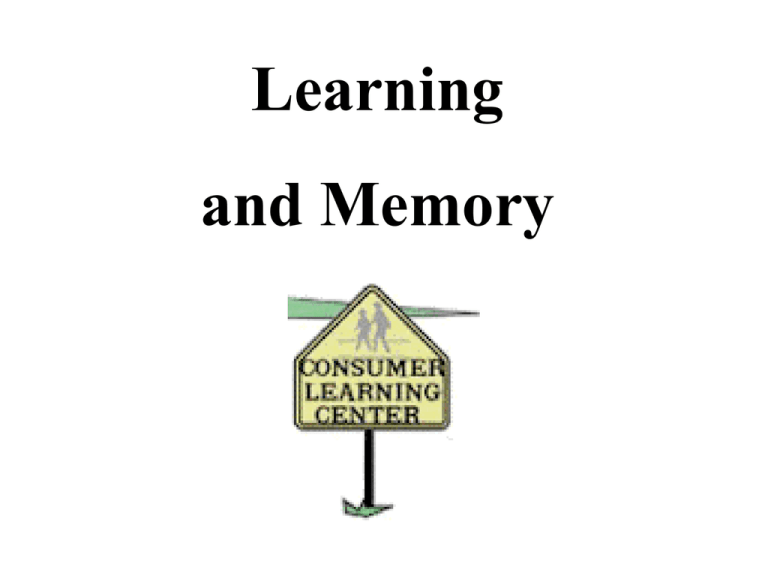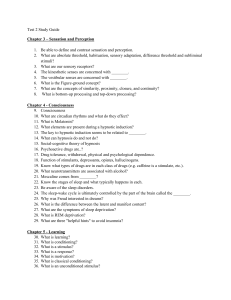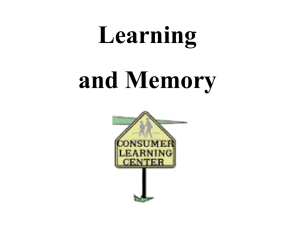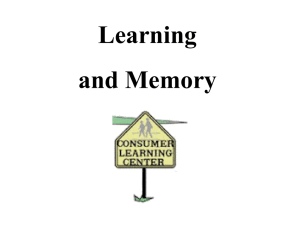Learning and Memory
advertisement

Learning and Memory What is Learning? A change in Behaviour caused by experience What is Consumer learning? Why is it important to understand how consumer’s learn? From a marketer’s perspective learning becomes teaching What do we want to teach them? Learning Theories Behaviorism Classical Conditioning Instrumental Conditioning Cognitive Reasoning Vicarious Classical Conditioning learning occurs when a stimulus (unconditioned stimulus UCS) elicits a response (unconditioned response UCR) that is paired with another stimulus (conditioned stimulus CS) that initially does not elicit a response on its own but will cause a similar response (conditioned response CR) over time because of its association with the first stimulus. Ivan Pavlov’s Classic Experiment Before Conditioning UCS (food in mouth) UCR (salivation) During Conditioning Neutral stimulus (tone) No salivation After Conditioning UCS (food in mouth) Neutral stimulus (tone) Slide 10 UCR (salivation) CS (tone) CR (salivation) Applications of Classical Conditioning • Applications: communications--advertising, public relations, • Goal: identify powerful positive stimulus and associate brand with it. • Examples of powerful, emotion causing stimuli: – beautiful, sexy people – patriotic themes, religious symbols – Music, beautiful scenes – Also, negative stimuli can be associated with competitors. • Requires repetition to make the association stick Credit card insignia may elicit spending responses The bears (UCS) naturally generate positive feelings (UCR) towards them Coke (CS) by itself and before conditioning, does not, illicit any positive feelings But coke (CS) is associated with the bears (UCS) Later ( in the store) you have a positive feeling towards coke (CR) The goal of advertisers is to get the exposed person at the grocery store to associate the positive feeling they had for the ad with the product Event sponsorship The sponsor (Bayer) wants the person viewing the event (UCS) to project the positive feelings (UCR) they get from the event with their product (CS); I.e. Bayer hopes the positive emotional feeling will transfer to their product outside the sporting context Positive emotional feeling toward the event can be intense because the person has chosen to be exposed to the event. What happens when the person’s favorite team loses? Instrumental or Operant Conditioning B.F. Skinner Positive Reinforcement Reinforcement of Consumption Punishment Negative Reinforcement Reinforcements Schedules Interval Fixed-Interval Reinforcement Variable-Interval Reinforcement Ratio Fixed-Ratio Reinforcement Variable-Ratio Reinforcement Frequency Marketing Sperry & Hutchinson, 1896. Consumer awareness of supermarket savings clubs or frequent-shopper programs (increased in 1997 versus 1996 (72 percent versus 62 percent respectively). ADVANTAGES OF FREQUENT BUYER PROGRAMS help to retain old customers and win new ones lower marketing costs and build brands. They generate increased frequency of visit, stimulate faster purchase cycles, add value make the sponsoring company stand out from the competition. They lock in consumer loyalty and make consumers resistant to product or service promotions by competitors. Effectiveness is easy to measure, and a valuable database is put in place for future programs. Suitability for frequency marketing programs customers have an ongoing need for your product or service. customers perceive little differentiation between your product or service and your competitors customers must consider your frequent buyer benefits to be valuable and definitely worth working for You must be willing to commit to the program long-term Frequent buyer programs are not short-term. They require a long-term commitment in order to work The product or service must lend itself to easy collection of proofs of purchase. Can you afford the program? The rewards, tracking, regular communication, and customer inquiries associated with the program require significant time and monetary resources. Do your competitors offer a frequency marketing program? If they do but you do not, you may want to give serious consideration to a program. Learning Theories Behaviourism Classical Conditioning Instrumental Conditioning Cognitive Reasoning Observation COGNITIVE LEARNING THEORY • Observational Learning • Reasoning Applications of Cognitive Learning Principles • Modelling The Role of Memory in Learning Stages • Encoding • Storage • Retrieval An Associative Network for Perfumes Draw an associative network for Pepsi Things to consider might include: • specific brands • a celebrity identified with Pepsi • related activities • related products • where purchased • packaging • attributes • concepts • feelings Nostalgia Nearly 10% of ads use Nostalgia trend appears to have begun in the 1980s, when marketing campaigns began to employ 1960s music The baby boomers are aging, entering a phase of life when looking back is natural “Every time I learn something new, it pushes some old stuff out of my brain” Forgetting Recognition Versus Recall • Recognition remembering when shown •Recall: remembering without stimulus 1. Zoom Zoom Zoom 2. Just for the fun of it Mazda Diet Coke 3. Grab Life By The Horns Dodge 4. Driven Nissan 5. I did it my way Viagra 6. The best a man can get." Gillette 7. The ultimate driving machine BMW 8. Engineered to be great cars 10. No More Tears Chrysler Visa J & J Baby Shampoo 11. Always low prices. Walmart 9. It's everywhere you want to be 12. Good to the last drop Maxwell House Advertising Recall as a function of Timing and Number of Exposures (Zielske 1959) 70 1 exposure / week for 13 weeks 60 50 13 exposures at 4 -week intervals 40 % 30 20 10 0 25 week of the 50 year How Can Marketers improve Memory retention? Repetition • Repetition of a central theme with some variation • KISS • how many times should a consumer be exposed to an ad before the advertising message is effective. Meaningful or more vivid/visual material increase the novelty of a stimulus Material presented first (primacy) or last (recency) is better retained than material presented in the middle






